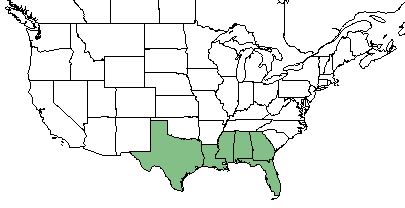Difference between revisions of "Agalinis pulchella"
(→Distribution) |
|||
| Line 23: | Line 23: | ||
==Description== <!-- Basic life history facts such as annual/perrenial, monoecious/dioecious, root morphology, seed type, etc. --> | ==Description== <!-- Basic life history facts such as annual/perrenial, monoecious/dioecious, root morphology, seed type, etc. --> | ||
| − | ''Agalinis pulchella'' is a dioecious annual that grows as a forb/herb.<ref name="USDA"/> | + | ''Agalinis pulchella'' is a dioecious annual that grows as a forb/herb.<ref name="USDA"/> Cotyledons were orbicular to orbicular-ovate and 0.8-1.3 mm wide and long.<ref name="Canne 1983">Canne JM (1983) The taxonomic significance of seedling morphology in ''Agalinis'' (Scrophulariaceae). Canadian Journal of Botany 61:1868-1874.</ref> |
==Distribution== | ==Distribution== | ||
Revision as of 17:27, 26 January 2018
| Agalinis pulchella | |
|---|---|
| Scientific classification | |
| Kingdom: | Plantae |
| Division: | Magnoliophyta - Flowering plants |
| Class: | Magnoliopsida - Dicots |
| Order: | Scrophulariales |
| Family: | Scrophulariaceae |
| Genus: | Agalinis |
| Species: | A. pulchella |
| Binomial name | |
| Agalinis pulchella Pennell | |

| |
| Natural range of Agalinis pulchella from USDA NRCS Plants Database. | |
Common name: St. Mark's false foxglove[1]
Contents
Taxonomic Notes
Synonym: Gerardia pulcherrima[1][2]
Description
Agalinis pulchella is a dioecious annual that grows as a forb/herb.[1] Cotyledons were orbicular to orbicular-ovate and 0.8-1.3 mm wide and long.[3]
Distribution
This species is found from Texas, eastward to Florida and Georgia.[1]
Ecology
Habitat
A. pulchella is found in pine savannas and sandhills of the southeast.[2]
Conservation and Management
Cultivation and restoration
Photo Gallery
References and notes
- ↑ 1.0 1.1 1.2 1.3 USDA NRCS (2016) The PLANTS Database (http://plants.usda.gov, 26 January 2018). National Plant Data Team, Greensboro, NC 27401-4901 USA.
- ↑ 2.0 2.1 Weakley AS (2015) Flora of the Southern and Mid-Atlantic States. Chapel Hill, NC: University of North Carolina Herbarium.
- ↑ Canne JM (1983) The taxonomic significance of seedling morphology in Agalinis (Scrophulariaceae). Canadian Journal of Botany 61:1868-1874.